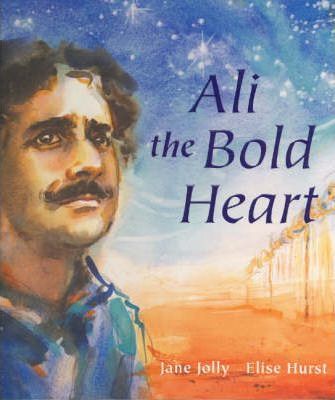Jane Jolly reveals that her inspiration for ‘Ali the Bold Heart’ came from the story she heard from a lawyer working with refugees. It was about an Iranian refugee, Ali, in the Woomera Detention Centre in the South Australian Simpson Desert. Ali tried for five years to gain a visa to allow him to stay in Australia, but he was unsuccessful. He was deported and not heard from again. Jane Jolly was inspired that Ali never gave up trying to gain a visa and so wrote this story.
Ali is a magician who flees from his homeland because life has become dangerous. He makes a long, difficult journey by boat to a new land and is locked up. Downhearted, Ali performs magic tricks for the children and the adults there. One night there is a sandstorm. In the morning, Ali is gone.
Jane Jolly uses figurative language which provides a memorable reading experience. For example, surrounding the refugee camp was ‘wire as sharp as tiger’s teeth’ and the gates ‘creaked and shuddered’. Elise Hurst, the illustrator, researched the people, landscape and detention camps to give the story authenticity but there is little detail provided. Rather, the artwork provokes emotional responses to the story. Intense watercolours generalise, rather than detail, the setting that renders the story universal and more open to interpretation for different readers. Facial expressions of both adults and children are realistic and draw the reader into this story. The landscapes are nondescriptive, perhaps reflecting the monotony of the setting. Astute viewers will notice there are illustrations of stars throughout, there to symbolise hope, according to the illustrator. The story is simply told with a minimum of detail ensuring that different ages can access this story according to their level of understanding. Ethical and moral issues are raised and depending on the maturity of the reader and viewer, there is much to talk about.

